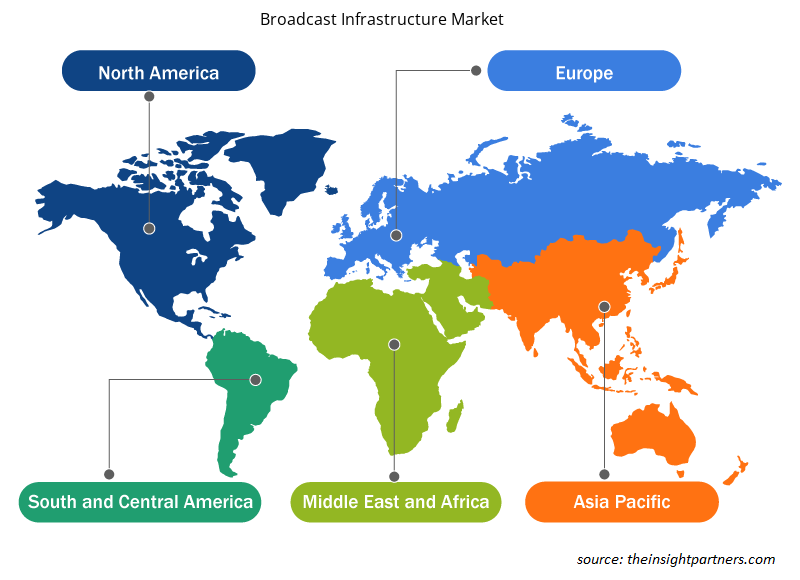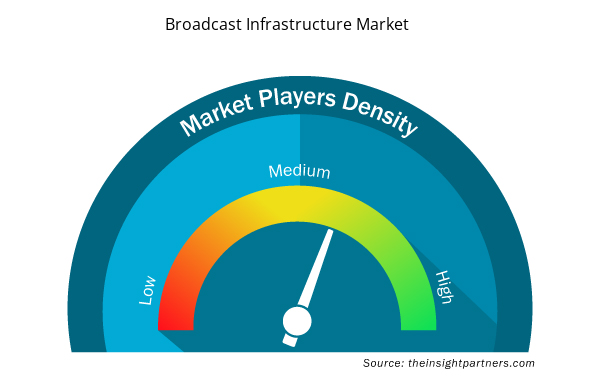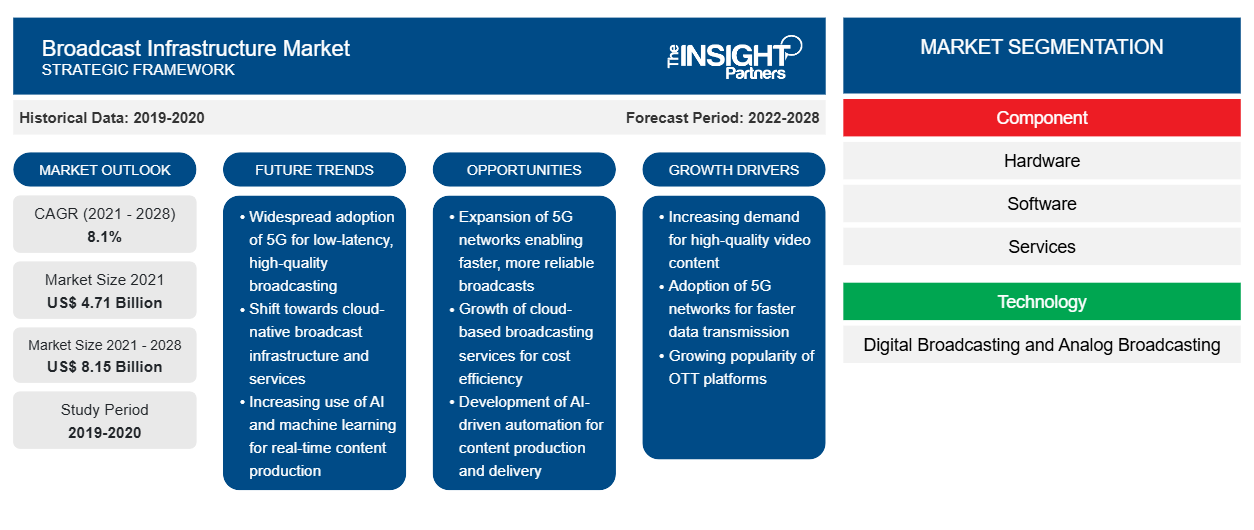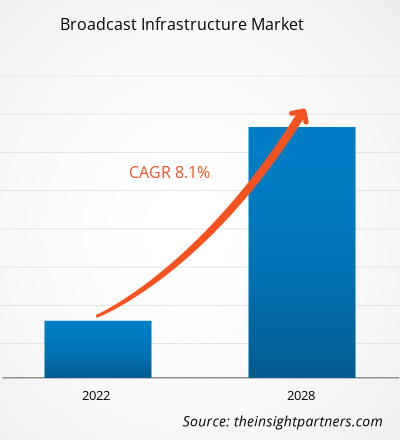[調査レポート] 放送インフラ市場は2021年に47億1,370万米ドルと評価され、2028年には81億4,570万米ドルに達すると予測されており、2021年から2028年にかけて8.1%のCAGRで成長すると予想されています。
放送業界がアナログからデジタル技術へとパラダイムシフトしたことで、比較的複雑な高度な放送インフラストラクチャが導入されました。放送業界では、インターネット プロトコル テレビ (IPTV)、Web TV、高精細テレビ (HDTV)、ペイパービューなどの新しい放送技術に対する大きな需要が見られています。充実したビデオ体験に対する需要は、世界中の放送局、特にアジアの放送局にとって道を開くものと期待されています。放送インフラストラクチャ市場を牽引するもう 1 つの重要な要因は、サーバー、セットトップ ボックス、ビデオ コンテンツ保護システム、および適切なツール、ミドルウェア、課金システムで構成される統合プラットフォームです。これにより、基盤となる IP ネットワークと DSL または光アクセス システムの組み合わせに基づいて、ビデオ オン デマンド、ストリーミング、タイムシフト TV など、さまざまな形式のさまざまな TV サービスの提供が可能になります。現在、ベンダーは、放送ハードウェア インフラストラクチャの高コスト、高メンテナンス コスト、および頻繁なハードウェア アップグレードのため、ハードウェア ベースのインフラストラクチャからソフトウェア ベースのインフラストラクチャに移行しています。放送業界では、ユーザーに優れた体験を提供し、放送インフラのベンダーにチャンスを生み出すために、技術開発による革命的なイノベーションが進められています。
要件に合わせてレポートをカスタマイズする
このレポートの一部、国レベルの分析、Excelデータパックなど、あらゆるレポートを無料でカスタマイズできます。また、スタートアップや大学向けのお得なオファーや割引もご利用いただけます。
- このレポートの主要な市場動向を入手してください。この無料サンプルには、市場動向から見積もりや予測に至るまでのデータ分析が含まれます。
COVID-19パンデミックが放送インフラ市場に与える影響
COVID-19パンデミックでは、膨大な数の人々が在宅勤務をし、オンラインで過ごす時間を増やし、デジタルへの移行を誇っています。デジタルリソースに対するこの需要は、いくつかのソフトウェアおよびプラットフォーム組織のシステムにさらなる負担をかけ、信頼性と品質を備えたサービスを提供する能力を妨げています。しかし、COVID-19の発生は、ビジネスの停止と労働力不足により、エンドユーザーへのビデオコンテンツの配信に携わるプレーヤーに悪影響を及ぼしています。COVID-19危機はまた、ビジネスのロックダウン、旅行禁止、サプライチェーンの混乱により、サプライヤーネットワークから顧客への配送体験まで、バリューチェーン全体の業務を大幅に混乱させました。lockdowns, travel bans, and supply chain disruptions.
市場洞察 – 放送インフラ市場
新しい放送技術の採用の増加
デジタル化の継続的な改善と可処分所得の増加により、市場では IPTV と HDTV の採用率が高まっています。充実したビデオ体験への需要は、世界中の放送局、特にアジアで道を開くと予想されています。オンデマンドの消費者視聴により、APAC 全域でブロードバンドの普及が進んでいます。さらに、Netflix などのサブスクリプションベースのオーバーザトップ (OTT) プラットフォームがアジアで人気を集めています。クラウドベースのインフラストラクチャ、クラウドベースのソリューションとマネージド サービス、ハイブリッド ネットワークへの政府支出の増加により、放送インフラストラクチャ市場の成長が促進されると予想されます。セキュリティへの懸念の高まりと顧客の信頼の維持により、放送局は新しい配信モデルを採用するようになるでしょう。予測期間中、すべての進歩と開発が市場の成長にプラスの影響を与える可能性があります。
コンポーネントベースの洞察
コンポーネントに基づいて、放送インフラ市場はハードウェア、ソフトウェア、サービスに分類されます。ソフトウェアセグメントは2020年に最大の市場シェアを占めました。
放送インフラ市場の地域別分析
予測期間を通じて放送インフラ市場に影響を与える地域的な傾向と要因は、Insight Partners のアナリストによって徹底的に説明されています。このセクションでは、北米、ヨーロッパ、アジア太平洋、中東およびアフリカ、南米および中米にわたる放送インフラ市場のセグメントと地理についても説明します。

- 放送インフラ市場の地域別データを入手
放送インフラ市場レポートの範囲
| レポート属性 | 詳細 |
|---|---|
| 2021年の市場規模 | 47億1000万米ドル |
| 2028年までの市場規模 | 81.5億米ドル |
| 世界のCAGR(2021年~2028年) | 8.1% |
| 履歴データ | 2019-2020 |
| 予測期間 | 2022-2028 |
| 対象セグメント | コンポーネント別
|
| 対象地域と国 | 北米
|
| 市場リーダーと主要企業プロフィール |
|
市場プレーヤーの密度:ビジネスダイナミクスへの影響を理解する
放送インフラ市場は、消費者の嗜好の変化、技術の進歩、製品の利点に対する認識の高まりなどの要因により、エンドユーザーの需要が高まり、急速に成長しています。需要が高まるにつれて、企業は提供内容を拡大し、消費者のニーズを満たすために革新を起こし、新たなトレンドを活用し、それが市場の成長をさらに促進しています。
市場プレーヤー密度とは、特定の市場または業界内で活動している企業または会社の分布を指します。これは、特定の市場スペースに、その市場規模または総市場価値に対してどれだけの競合相手 (市場プレーヤー) が存在するかを示します。
放送インフラ市場で事業を展開している主要企業は次のとおりです。
- シスコシステムズ株式会社
- クライド放送技術
- CSコンピュータシステムズ株式会社
- ダキャスト株式会社
- EVS 放送機器 SA
免責事項:上記の企業は、特定の順序でランク付けされていません。

- 放送インフラ市場のトップキープレーヤーの概要を入手
放送インフラ市場で活動する企業は、主に高度で効率的な製品の開発に重点を置いています。
- 2021 年 6 月、放送および新メディア制作向けライブ ビデオ テクノロジーの大手プロバイダーである EVS は、Gravity Media との提携を発表し、同社の新しい統合ビデオ判定および通信ソリューションの中核テクノロジーとして Xeebra マルチカメラ レビュー システムを提供しました。
- 2021 年 6 月、Ross Video はメディアアセット ワークフロー ソリューション企業である Primestream の買収を発表しました。これらのソリューションは、エンタープライズ、デジタル メディア、スポーツ、放送など、さまざまな市場分野の顧客によって使用されています。同社のソリューションは、各市場における独特でますます複雑化するクリエイティブ、ビジネス、テクノロジーの課題を解決するように設計されています。この買収により、Ross は当然ながら、Streamline メディアアセット管理ソリューションを Primestream 製品と徐々に融合し、完全に統合されたグラフィックスおよび制作アセット管理プラットフォームを構築することを目指します。
放送インフラ市場は以下のように分類されています。
放送インフラ市場 – コンポーネント別
- ハードウェア
- ソフトウェア
- サービス
放送インフラ市場 – テクノロジー別
- デジタル放送
- アナログ放送
放送インフラ市場 – アプリケーション別
- オーバー
- 地上
- 衛星
- IPTV
- その他
放送インフラ市場 – 地域別
- 北米
- 私たち
- カナダ
- メキシコ
- ヨーロッパ
- ドイツ
- フランス
- イタリア
- 英国
- ロシア
- その他のヨーロッパ
- アジア太平洋(APAC)
- オーストラリア
- 中国
- インド
- 日本
- 韓国
- その他のアジア太平洋地域
- 中東・アフリカ(MEA)
- サウジアラビア
- アラブ首長国連邦
- 南アフリカ
- MEAの残り
- 南アメリカ(SAM)
- ブラジル
- アルゼンチン
- SAMの残り
放送インフラ市場 – 企業プロファイル
- シスコシステムズ株式会社
- クライド放送技術
- CSコンピュータシステムズ株式会社
- ダキャスト株式会社
- EVS 放送機器 SA
- グラスバレー
- カルトゥーラ
- ネビオン
- ロスビデオ株式会社
- 子溪
- 過去2年間の分析、基準年、CAGRによる予測(7年間)
- PEST分析とSWOT分析
- 市場規模価値/数量 - 世界、地域、国
- 業界と競争環境
- Excel データセット



Report Coverage
Revenue forecast, Company Analysis, Industry landscape, Growth factors, and Trends

Segment Covered
This text is related
to segments covered.

Regional Scope
North America, Europe, Asia Pacific, Middle East & Africa, South & Central America

Country Scope
This text is related
to country scope.
よくある質問
US led the broadcast infrastructure market globally with a market share of 68.7% in the year 2020. For instance, For instance in 2021, DigitalBridge Group, an American made an announcement to acquire a majority stake in Vertical Bridge, the largest operator of wireless communications infrastructure in the US with an aim to meet the rising demands for broadcast infrastructure solutions. Significant investments in the 5G infrastructure by the government of the US has created a tremendous long-term growth opportunities for telecommunications infrastructure in the region.
The major companies in broadcast infrastructure includes Computer System, Grass Valley, EVS Broadcast Equipment, Nevion, Kaltura, among others. The ranking has been derived analysing multiple parameters such as annual revenue earned from broadcast infrastructure portfolio, client base, geographic locations, R&D expenditure, brand image, and number of employees, among others. These companies are actively participating in developing broadcast infrastructure for various applications.
The broadcast infrastructures have been in use for several years worldwide, however, the technology has been experiencing immense demand in recent years. The noteworthy increasing adoption of new broadcast technologies and migration from hardware to software based infrastructure is supporting the growth of broadcast infrastructure market. Moreover, the demand for cloud-based solutions in the broadcast industry for low cost and high scalability increases, the opportunities for market players who provide cost-effective and efficient streaming will propel the growth of the market.
In 2020, North America led the market with a substantial revenue share, followed by Europe, and APAC. Asia Pacific is a prospective market for broadcast infrastructure market players.
Increasing demand of Digital Terrestrial TV (DTTV) is the key opportunity for the broadcast infrastructure market. Growing demand of smart TVs, and advancements in telecom and broadcast industry is anticipated to drive the growth of Digital Terrestrial Television (DTT). With increasing consumption of TV sets and expenditure on terrestrial networks for quality, entertainment, and family friendly purpose, the demand for DTT has boosted.
The global broadcast infrastructure market was dominated by terrestrial segment with market share of 44% in 2020. Terrestrial television refers to methods of television broadcasting which do not include satellite transmission or through underground cables. The transition to digital terrestrial TV from analog terrestrial TV can be considered a significant development for the broadcasting industry. While the implementation of digital broadcasting has been led by satellite, cable, and to some extent IPTV, it is the evolution of the terrestrial broadcast platform that perhaps brings most benefits to the society.
Trends and growth analysis reports related to Electronics and Semiconductor : READ MORE..
The List of Companies - Broadcast Infrastructure Market
- Cisco Systems, Inc.
- Clyde Broadcast Technology
- CS Computer Systems Ltd.
- Dacast Inc.
- EVS Broadcast Equipment SA
- Grass Valley
- Kaltura
- Nevion
- Ross Video Ltd
- Zixi
The Insight Partners performs research in 4 major stages: Data Collection & Secondary Research, Primary Research, Data Analysis and Data Triangulation & Final Review.
- Data Collection and Secondary Research:
As a market research and consulting firm operating from a decade, we have published and advised several client across the globe. First step for any study will start with an assessment of currently available data and insights from existing reports. Further, historical and current market information is collected from Investor Presentations, Annual Reports, SEC Filings, etc., and other information related to company’s performance and market positioning are gathered from Paid Databases (Factiva, Hoovers, and Reuters) and various other publications available in public domain.
Several associations trade associates, technical forums, institutes, societies and organization are accessed to gain technical as well as market related insights through their publications such as research papers, blogs and press releases related to the studies are referred to get cues about the market. Further, white papers, journals, magazines, and other news articles published in last 3 years are scrutinized and analyzed to understand the current market trends.
- Primary Research:
The primarily interview analysis comprise of data obtained from industry participants interview and answers to survey questions gathered by in-house primary team.
For primary research, interviews are conducted with industry experts/CEOs/Marketing Managers/VPs/Subject Matter Experts from both demand and supply side to get a 360-degree view of the market. The primary team conducts several interviews based on the complexity of the markets to understand the various market trends and dynamics which makes research more credible and precise.
A typical research interview fulfils the following functions:
- Provides first-hand information on the market size, market trends, growth trends, competitive landscape, and outlook
- Validates and strengthens in-house secondary research findings
- Develops the analysis team’s expertise and market understanding
Primary research involves email interactions and telephone interviews for each market, category, segment, and sub-segment across geographies. The participants who typically take part in such a process include, but are not limited to:
- Industry participants: VPs, business development managers, market intelligence managers and national sales managers
- Outside experts: Valuation experts, research analysts and key opinion leaders specializing in the electronics and semiconductor industry.
Below is the breakup of our primary respondents by company, designation, and region:

Once we receive the confirmation from primary research sources or primary respondents, we finalize the base year market estimation and forecast the data as per the macroeconomic and microeconomic factors assessed during data collection.
- Data Analysis:
Once data is validated through both secondary as well as primary respondents, we finalize the market estimations by hypothesis formulation and factor analysis at regional and country level.
- Macro-Economic Factor Analysis:
We analyse macroeconomic indicators such the gross domestic product (GDP), increase in the demand for goods and services across industries, technological advancement, regional economic growth, governmental policies, the influence of COVID-19, PEST analysis, and other aspects. This analysis aids in setting benchmarks for various nations/regions and approximating market splits. Additionally, the general trend of the aforementioned components aid in determining the market's development possibilities.
- Country Level Data:
Various factors that are especially aligned to the country are taken into account to determine the market size for a certain area and country, including the presence of vendors, such as headquarters and offices, the country's GDP, demand patterns, and industry growth. To comprehend the market dynamics for the nation, a number of growth variables, inhibitors, application areas, and current market trends are researched. The aforementioned elements aid in determining the country's overall market's growth potential.
- Company Profile:
The “Table of Contents” is formulated by listing and analyzing more than 25 - 30 companies operating in the market ecosystem across geographies. However, we profile only 10 companies as a standard practice in our syndicate reports. These 10 companies comprise leading, emerging, and regional players. Nonetheless, our analysis is not restricted to the 10 listed companies, we also analyze other companies present in the market to develop a holistic view and understand the prevailing trends. The “Company Profiles” section in the report covers key facts, business description, products & services, financial information, SWOT analysis, and key developments. The financial information presented is extracted from the annual reports and official documents of the publicly listed companies. Upon collecting the information for the sections of respective companies, we verify them via various primary sources and then compile the data in respective company profiles. The company level information helps us in deriving the base number as well as in forecasting the market size.
- Developing Base Number:
Aggregation of sales statistics (2020-2022) and macro-economic factor, and other secondary and primary research insights are utilized to arrive at base number and related market shares for 2022. The data gaps are identified in this step and relevant market data is analyzed, collected from paid primary interviews or databases. On finalizing the base year market size, forecasts are developed on the basis of macro-economic, industry and market growth factors and company level analysis.
- Data Triangulation and Final Review:
The market findings and base year market size calculations are validated from supply as well as demand side. Demand side validations are based on macro-economic factor analysis and benchmarks for respective regions and countries. In case of supply side validations, revenues of major companies are estimated (in case not available) based on industry benchmark, approximate number of employees, product portfolio, and primary interviews revenues are gathered. Further revenue from target product/service segment is assessed to avoid overshooting of market statistics. In case of heavy deviations between supply and demand side values, all thes steps are repeated to achieve synchronization.
We follow an iterative model, wherein we share our research findings with Subject Matter Experts (SME’s) and Key Opinion Leaders (KOLs) until consensus view of the market is not formulated – this model negates any drastic deviation in the opinions of experts. Only validated and universally acceptable research findings are quoted in our reports.
We have important check points that we use to validate our research findings – which we call – data triangulation, where we validate the information, we generate from secondary sources with primary interviews and then we re-validate with our internal data bases and Subject matter experts. This comprehensive model enables us to deliver high quality, reliable data in shortest possible time.


 このレポートの無料サンプルを入手する
このレポートの無料サンプルを入手する